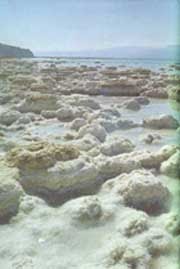The 82nd verse of Surah Hud, clearly states the kind of the disaster that befell the people of Lut. “When Our Decree issued, We turned (the cities) upside down, and rained down on them brimstones hard as baked clay, spread, layer on layer”
The statement of “turning (the cities) upside down” implies that the region was totally destroyed by a violent earthquake. Accordingly, The Lake of Lut, where the destruction took place, bears “obvious” evidence of such a disaster.
We quote German archaeologist Werner Keller as follows;
Together with the base of this mighty fissure, which runs precisely through this area, the Vale of Siddim, including Sodom and Gomorrah, plunged one day into the abyss. Their destruction came about through a great earthquake which was probably accompanied by explosions, lightning, issue of natural gas and general conflagration. (1)
As a matter of fact, the Lake of Lut, or the Dead Sea as it is otherwise known, is located right on the top of an active seismic region, that is, an earthquake zone:
The base of the dead sea is located with a tectonic rooted downfall. This valley is located in a tension stretching between the Taberiye Lake in the north, and mid of Arabah Valley in the south.(2)
The event was expressed as “we rained down on them brimstones hard as baked clay, spread, layer on layer” in the last part of the verse. This is in all probability meant to be the volcanic explosion that took place on the banks of the Lake of Lut, and because of which the rocks and stones that erupted were in a “baked form”. (The same event is related in the 173rd verse of Surat ash-Shuara as “We rained down on them a shower (of brimstone): and evil was the shower on those who were admonished (but heeded not)!”)
In relation to this subject, Werner Keller writes;
In relation to this subject, Werner Keller writes;
The subsidence released volcanic forces that had been lying dormant deep down along the whole length of the fracture. In the upper valley of the Jordan near Bashan there are still towering craters of extinct volcanoes; great stretches of lava and deep layers of basalt have been deposited on the limestone surface.(3)
A satellite photograph of the region where the people of Lut lived
An illustration showing the volcanic eruption and the collapse that followed it, which caused the whole people to disappear
A satellite photograph of the region where the people of Lut lived
The Lake of Lut, or Dead Sea as differently called.
This is the lowest point on the earth. In other areas which are lower than sea level, the depth is at most 100 meters. Another property of the Lake of Lut is that the salt content of its water is very high, the density being nearly 30 %. Because of this, no living organism, such as fish or moss, can survive in this lake. This is why the Lake of Lut is called the “Dead Sea” in Western literature.
Photographs of the Lake of Lut taken from satellite.An illustration showing the volcanic eruption and the collapse that followed it, which caused the whole people to disappear
The interesting structure of River of Sheri’at and the Lake of Lut make up only a small part of the crack or split passing from this region of the earth. The condition and length of this crack have only recently been discovered.
The fault starts from the outskirts of Mount Taurus, stretches to the southern shores of the Lake of Lut and proceeds over the Arabian desert to the Gulf of Aqaba and continues across the Red Sea, ending up in Africa. Along the length of it, strong volcanic activities are observed. Black basalt and lava exist in the Galilee Mountains in Israel, high plain regions of Jordan, the Gulf of Aqaba and other areas nearby.
National Geographic makes the following comment on December 1957;
- The mount of Sodom, a barren wasteland, rises sharply above the dead sea. No one has ever found the destroyed cities of Sodom and Gomorrah, but scholars believe that they stood in the Vale of Siddim across from these cliffs. Possibly flood waters of the Dead Sea engulfed them following an earthquake.
The destruction of Pompeii came by means of the eruption of the volcano Vesuvius.
Some corpses uncovered at Pompeii and displayed in museums.









No comments:
Post a Comment